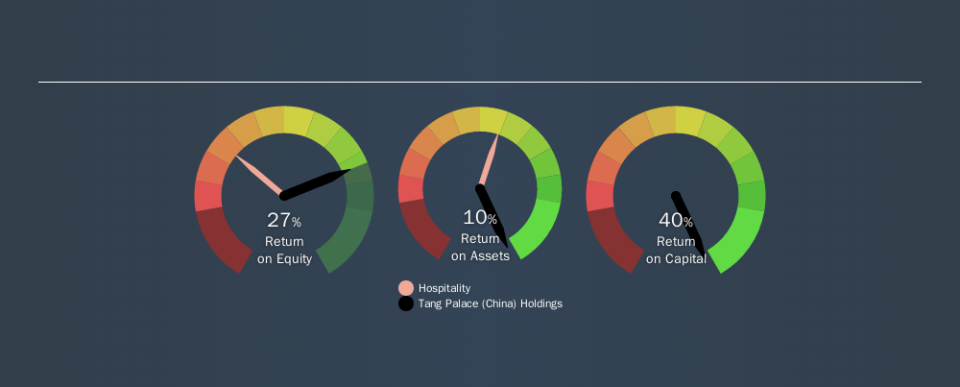Why Tang Palace (China) Holdings Limited’s (HKG:1181) Return On Capital Employed Is Impressive

Today we are going to look at Tang Palace (China) Holdings Limited (HKG:1181) to see whether it might be an attractive investment prospect. In particular, we'll consider its Return On Capital Employed (ROCE), as that can give us insight into how profitably the company is able to employ capital in its business.
First, we'll go over how we calculate ROCE. Next, we'll compare it to others in its industry. Last but not least, we'll look at what impact its current liabilities have on its ROCE.
What is Return On Capital Employed (ROCE)?
ROCE is a measure of a company's yearly pre-tax profit (its return), relative to the capital employed in the business. In general, businesses with a higher ROCE are usually better quality. In brief, it is a useful tool, but it is not without drawbacks. Author Edwin Whiting says to be careful when comparing the ROCE of different businesses, since 'No two businesses are exactly alike.
How Do You Calculate Return On Capital Employed?
Analysts use this formula to calculate return on capital employed:
Return on Capital Employed = Earnings Before Interest and Tax (EBIT) ÷ (Total Assets - Current Liabilities)
Or for Tang Palace (China) Holdings:
0.40 = CN¥263m ÷ (CN¥1.2b - CN¥531m) (Based on the trailing twelve months to June 2019.)
So, Tang Palace (China) Holdings has an ROCE of 40%.
Check out our latest analysis for Tang Palace (China) Holdings
Does Tang Palace (China) Holdings Have A Good ROCE?
When making comparisons between similar businesses, investors may find ROCE useful. Tang Palace (China) Holdings's ROCE appears to be substantially greater than the 5.1% average in the Hospitality industry. I think that's good to see, since it implies the company is better than other companies at making the most of its capital. Putting aside its position relative to its industry for now, in absolute terms, Tang Palace (China) Holdings's ROCE is currently very good.
The image below shows how Tang Palace (China) Holdings's ROCE compares to its industry, and you can click it to see more detail on its past growth.
It is important to remember that ROCE shows past performance, and is not necessarily predictive. ROCE can be deceptive for cyclical businesses, as returns can look incredible in boom times, and terribly low in downturns. This is because ROCE only looks at one year, instead of considering returns across a whole cycle. Since the future is so important for investors, you should check out our free report on analyst forecasts for Tang Palace (China) Holdings.
What Are Current Liabilities, And How Do They Affect Tang Palace (China) Holdings's ROCE?
Short term (or current) liabilities, are things like supplier invoices, overdrafts, or tax bills that need to be paid within 12 months. Due to the way the ROCE equation works, having large bills due in the near term can make it look as though a company has less capital employed, and thus a higher ROCE than usual. To counter this, investors can check if a company has high current liabilities relative to total assets.
Tang Palace (China) Holdings has total liabilities of CN¥531m and total assets of CN¥1.2b. As a result, its current liabilities are equal to approximately 45% of its total assets. Tang Palace (China) Holdings's ROCE is boosted somewhat by its middling amount of current liabilities.
What We Can Learn From Tang Palace (China) Holdings's ROCE
Even so, it has a great ROCE, and could be an attractive prospect for further research. Tang Palace (China) Holdings shapes up well under this analysis, but it is far from the only business delivering excellent numbers . You might also want to check this free collection of companies delivering excellent earnings growth.
For those who like to find winning investments this free list of growing companies with recent insider purchasing, could be just the ticket.
We aim to bring you long-term focused research analysis driven by fundamental data. Note that our analysis may not factor in the latest price-sensitive company announcements or qualitative material.
If you spot an error that warrants correction, please contact the editor at editorial-team@simplywallst.com. This article by Simply Wall St is general in nature. It does not constitute a recommendation to buy or sell any stock, and does not take account of your objectives, or your financial situation. Simply Wall St has no position in the stocks mentioned. Thank you for reading.

